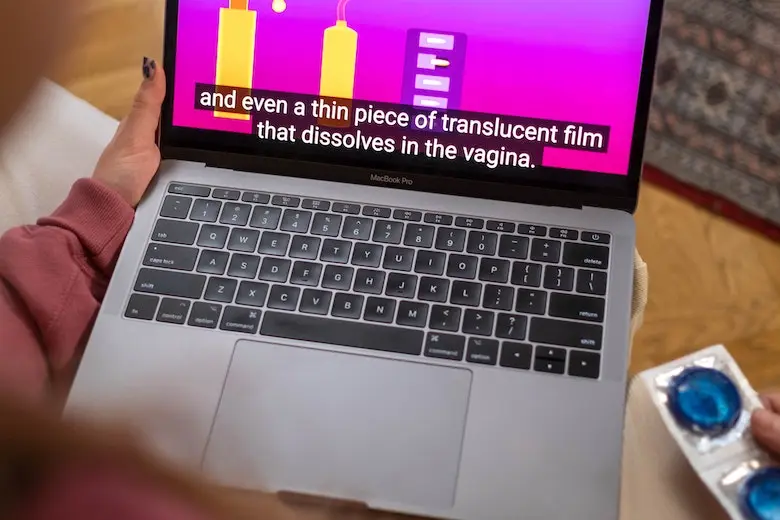Closed captions and subtitles are both ways for hearing-impaired people to enjoy video content. They’re also both used by people whose first language isn’t English or who have trouble understanding English. But there are some subtle differences between the two that might affect how you use them – or how you decide whether they’re necessary at all. In this guide, we’ll cover what closed captions and subtitles are, how they work, why they matter (both in terms of accessibility and marketing), and what their differences are to be able to make an educated decision about which suits your requirements.

Table of Contents
Closed Captions vs. Subtitles
- Closed Captions are a text transcription of spoken dialogue. They’re available in the same format as the video, and they can be turned on or off at any time.
- Subtitles are text transcription of spoken dialogue and on-screen text (e.g., names, places). Unlike closed captions, subtitles also include translations into other languages and cultural references that wouldn’t be obvious to someone who doesn’t speak English as their first language. Subtitles are usually presented below videos rather than over them; however, some players allow you to choose where your subtitles appear on the screen–for example, YouTube allows you to choose whether you want subtitles under or above your video player’s interface controls.*
What Are Closed Captions?
Closed captions are a text track that’s separate from the video and audio tracks. They’re embedded in the video itself, so they can be displayed on-screen or burned into your footage. Closed captions give you more control over how your videos look, as well as how they’re delivered to viewers with hearing disabilities.
Closed captions can also help you reach new audiences who prefer to read subtitles instead of listening to audio tracks (or who don’t speak English).
How Do They Work?
Closed captions and subtitles are both text that appears on the screen, but they serve different purposes. Closed captions are meant to be read by people who are deaf or hard of hearing; subtitles are meant to be read by people who don’t speak the language in which a program is being broadcasted (or written).
Subtitling involves having someone translate what’s being said in dialogue into another language and then write it out as subtitles in normal script format–no special symbols or formatting involved! This can sometimes be tricky because there may be slang terms unique to certain regions/cultures that need translating as well as idioms and expressions used only by native speakers.
Why Should You Care About Closed Captions?
In today’s rapidly evolving digital landscape, accessibility has become an essential consideration for content creators and consumers alike. One key aspect of accessibility that often goes unnoticed or underestimated is closed captions. These unobtrusive, text-based overlays provide a written representation of spoken content in videos, making them an invaluable tool for a diverse range of audiences. While closed captions were initially developed to cater to the needs of the deaf and hard of hearing, their significance extends far beyond that demographic. Here’s why you should care about closed captions and their impact on both creators and viewers.
What Are Subtitles?
Subtitles play a crucial role in enhancing the accessibility and comprehension of audiovisual content, making it accessible to a wider audience, bridging linguistic and cultural gaps, and providing a more immersive experience. In essence, subtitles are textual representations of spoken dialogue or narration that appear on the screen, typically at the bottom, synchronized with the audio.
Why Should You Care About Subtitles?
In an increasingly interconnected world where media consumption spans languages and cultures, subtitles have emerged as an invaluable tool for bridging linguistic gaps and enhancing the entertainment and educational experience. While some may view subtitles as a mere convenience, their significance runs deeper, contributing to improved language skills, cultural understanding, and even cognitive development. Here’s why you should care about subtitles and the benefits they offer.
What is the Distinction Between Closed Captions and Subtitles
Asking: “what’s the difference between closed captions and subtitles” there are several answers. Closed Captions are a text version of the spoken word (and sometimes visual cues) used in live broadcasts or video on demand (VOD). They’re also referred to as “CC” or “closed captioning.” Subtitles are an alternate audio track that displays words as they are being spoken in another language, the written form of dialogue in foreign films, TV shows, and other videos.
Subtitles should not be confused with closed captions because they serve different purposes: Closed captions help people who are deaf or hard of hearing understand what’s going on in their favorite shows; subtitles assist viewers who speak languages other than English while watching content they’ve chosen themselves (such as a movie).
The differences between closed captions and subtitles are subtle but important.
Closed captions are a text-based representation of the audio track. They’re typically displayed at the top of a video, but they can also be shown in other locations on your screen.
Subtitles are a text-based representation of dialogue in a video. Subtitles are usually displayed on the bottom of the screen and may include additional information such as sound effects or music that is not part of what’s being spoken by characters on screen–for example, if someone drops something in an action scene, you might see “thunk” written below where it lands so you know what happened without having to follow along closely with your eyes (and ears).











Leave a Reply